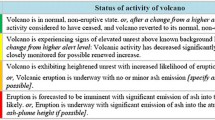Abstract
This study examines the normative functioning of the volcano warning system on the Island of Hawaii. The research seeks to identify the combination of factors, both environmental and social, which allows the system to operate with success. On the basis of the findings, several recommendations are offered for improving environmental hazard warning systems.
Similar content being viewed by others
Literature cited
Barton, A. 1969.Communities in disaster. Doubleday, New York.
Bonk, W., R. Lachman, and M. Tatsuoka. 1960.A report of human behavior during the tsunami of May 23, 1960. Hawaiian Academy of Science, Hilo.
Burton, I., R. Kates, and G. White. 1978.The environment as hazard. Oxford University Press, New York.
Dynes, R. 1970.Organized behavior in disaster. D. C. Heath and Company, Lexington, Massachusetts.
Federal Emergency Management Agency. 1979.Disaster Information. July.
Federal Register. 1979. “Proposed Rule, Federal Disaster Assistance Administration.” Vol. 44, No. 69, 9 April, pp. 21216–21223.
Federal Register. 1979. “Ratification of Actions, Federal Emergency Management Agency.” Vol. 44, No. 147, 30 July, pp. 44790–44796.
Islam, M. A. 1971.Human adjustment to cyclone hazard: A case study of Char Jabbar (University of Colorado, Institute of Behavioral Science, Natural Hazards Working Paper No. 18). University of Colorado, Boulder.
Mileti, D. 1975.Natural hazard warning systems in the United States: A research assessment (University of Colorado, Institute of Behavioral Science, Program on Technology, Environment and Man, Monograph No. NSF-RS-E-75-013). University of Colorado, Boulder.
Mileti, D., T. Drabek, and J. Haas. 1975.Human systems in extreme environments: A sociological perspective (University of Colorado, Institute of Behavioral Science, Program on Technology, Environment and Man, Monograph No. 21). University of Colorado, Boulder.
Mileti, D., J. Hutton, and J. Sorensen. 1979.Earthquake prediction and public policy. A report to the National Science Foundation. Washington, D.C.
Murton, B., and S. Shimabukuro. 1974. Human Adjustment to Volcanic Hazard in Puna District, Hawaii. In Gilbert F. White (Ed.),Natural hazards. Oxford, New York.
Quarantelli, E. L. (Ed.). 1978.Disasters: Theory and research. Sage, Beverly Hills, California.
White, G., and J. Haas. 1975.Assessment of research on natural hazards. MIT Press, Cambridge, Massachusetts.
Author information
Authors and Affiliations
Rights and permissions
About this article
Cite this article
Sorensen, J.H., Gersmehl, P.J. Volcanic hazard warning system: Persistence and transferability. Environmental Management 4, 125–136 (1980). https://doi.org/10.1007/BF01866509
Issue Date:
DOI: https://doi.org/10.1007/BF01866509




